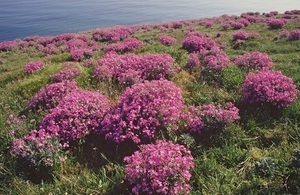Rare plants to receive ‘intensive care’ on Devon coast
Conservation work to ensure the survival of 2 of Britain’s rarest plants to be carried out by Natural England and Torridge District Council.

Sea stock (Matthiola sinuata) © Peter Wakely / Natural England
The sand dunes of Northam Burrows are home to the water germander – found in only 2 other locations in England – and the sea stock, which only grows in a handful of other places. The dunes are so important to these and a range of other plants that they are protected as a Site of Special Scientific Interest.
However, the spread of thick vegetation in the area is threatening the survival of these rare plants.
In order to help them thrive, Torridge District Council and Natural England – the government’s conservation adviser – are to begin essential conservation work later this autumn.
Diggers will be used to carefully ‘scrape’ off a thin layer of vegetation, exposing bare sand across parts of the site in which sea stock and water germander can thrive. The growth of the more vigorous vegetation will then be held in check with the help of grazing by sheep and horses.
The fen orchid has already become extinct from the Taw-Torridge dunes, but with the help of this “intensive care” plan it is hoped that the sea stock and water germander will avoid a similar fate.
Water germander (Teucrium scordium), which looks a little like mint but smells of garlic, prefers damp open ground with no other vegetation, and will not grow under scrub. To reproduce it sends out creepers, but is fairly exacting in its requirements, and doesn’t like too many other plants nearby to compete with it. It favours the damp sand dune slacks at Northam Burrows but is being crowded out by grasses and other species. It’s only other strongholds in England are in nearby Braunton Burrows and Cambridgeshire.
Sea stock (Matthiola sinuata), with its pale violet flowers and delightful perfume, has evolved to thrive in pure sand. It cannot tolerate dense vegetation, shade or high nutrient levels.
Justin Gillett, Natural England’s conservation adviser, said: “Northam Burrows is a superb coastal site and home to some of the rarest plants in the country. But the vegetation on the dunes is causing serious problems for these plants.
“Every single species plays an important role in the fabric of our natural environment and we can’t afford to see the water germander and the sea stock disappear from the area like the fen orchid. That’s why Natural England and Torridge District Council are keen to give them a helping hand. This work is seen as critical in reversing the decline in key species for which the site has become renowned.”
Councillor Roger Johnson, deputy leader and lead member for Northam Burrows, said: “The Burrows really is a unique environment but unless we manage it carefully some of our rarest wildlife treasures could be lost forever. I am really excited that this project will both maintain and increase the area of grazing for domesticated stock, but also add diversity to the landscape of this important site for the benefit of the public. Perhaps most importantly though it will provide the intensive care now needed to safeguard all the rare species for which the site has been famed for over a hundred years. It is great to see so many organisations both national and local come together to deliver this welcome and carefully planned package of conservation measures.”
Northam Burrows hosts no fewer than 46 nationally and locally rare, scarce and threatened plant species which give the site its distinctive characteristics. In fact, this particular combination of rarities is thought to be unique to this single site in Britain.
The conservation work is expected to take up to 2 years to complete. As well as benefitting the protected plants it will appeal to visitors by creating different areas of interest across this larger site and enhancing access. It is being funded through Higher Level Stewardship, a government scheme that provides grants to land managers and farmers to help them manage important sites for nature conservation.